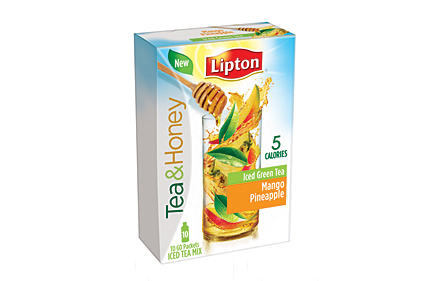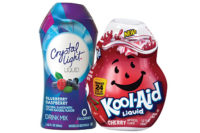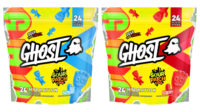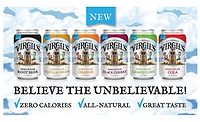Whether it’s low-calorie varieties, energy-boosting ingredients or popular flavor trends, the drink mix category has seen a wave of innovations that help it remaincompetitive in the beverage marketplace. During the recession, the drink mix category experienced an
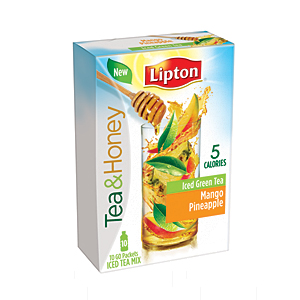
|
|
Featuring traditional and non-traditional flavors, Unilever USA’s Lipton Tea & Honey is a low-calorie drink mix that contains 5 calories in each serving. |
uptick in sales, but since then, sales have remained relatively flat, says Garima Goel Lal, senior analyst with Chicago-based Mintel.
The fruit drink mix segment saw sales grow 5.8 percent for more than $621 million in sales in U.S. supermarkets, drug, gas, convenience and mass merchandise retailers, excluding Walmart, club and liquor stores, for the 52 weeks ending April 15, according to SymphonyIRI Group, Chicago.
Showing the most growth in the drink mix segment was Mio, which was released last year by Northfield, Ill.-based Kraft Foods. Mio sales accounted for $82.7 million in sales last year making it the No. 2 best-selling fruit drink mix trailing only Kool Aid, a fellow Kraft Foods brand, based on SymphonyIRI data.
“Mio has provided some momentum to fruit drink mixes, but that has been copied by many private label [brands] already,” Goel Lal says. “Nevertheless, it’s a new type of product, which is not just another beverage mix, but it’s a new product [that] gives a different avenue to users in terms of usage instead of powder.”
Classifying Mio as a liquid concentrate versus a drink mix, Richard Haffner, head of global beverages research with Chicago-based Euromonitor International, notes that in Europe, liquid concentrates have been more popular than powdered drink mixes.
“I think that Mio is trying to create a new usage [that’s] more upscale, and they’re searching for the best way to fit in,” he says. “They switched over to introducing energy-type drinks and I think that’s the new product that they’ve been going after now.”
Earlier this year, Kraft Foods expanded the Mio brand with the release of Mio Energy, which is available in Black Cherry and Thunder Punch varieties and features caffeine as well as vitamins B3, B6 and B12.
Flavorful trends
As drink mix products look to expand their user bases, analysts are seeing beverage manufacturers introduce flavor varieties that have established followings in other categories, including trendy lemonade and tea varieties.
“I think what you’re seeing there is [manufacturers] are looking at what’s going on in ready-to-drink teas and then looking to introduce a flavor that was a growth flavor in that area,” Haffner says. “I see them looking past the powdered concentrate category and looking at what’s going on in other categories and then duplicating the flavor experience.”
This year, Kraft Foods’ Country Time brand launched its first entry into the tea segment: a Half Lemonade & Half Iced Tea flavored drink mix. To spark excitement about the new variety, the brand also launched a campaign to help develop a nickname for the brand and enlisted the help of celebrities, including National Football League quarterback Drew Brees and singer and actress Kristen Chenoweth.
Mintel’s Goel Lal says that in 2006, flavor profiles for drink mixes were more traditional, such as orange, strawberry and raspberry. Comparatively, in 2011 and 2012, the top flavors are similar to the popular flavors in other beverage categories such as tea and juice drinks.
The innovations taking place in the ready-to-drink market also have created challenges for drink mixes to stay competitive.
“Beverage mixes offer a good solution, a value-oriented solution to replace traditional drinks, but when we’re talking about innovative beverages like energy drinks or even sports drinks, the question the manufacturer needs to ask is, ‘Are we giving a similar experience as the original beverage?’” Goel Lal says. “I think the key to growth would be if they could somehow replicate that experience even better in drink mixes.”
Drink mix segments also have seen a lot of innovation around low-calorie varieties, Euromonitor’s Haffner says.
This year, Unilever USA released low-calorie Lipton Tea & Honey single-serve to-go packets and pitcher packets of flavored iced tea mixes infused with honey. Made from real tea leaves and fruit flavors, Lipton Tea & Honey contains only 5 calories in each serving and comes in a variety of traditional and non-traditional flavors. Available in both its pitcher and single-serve options are Peach Apricot Iced Black Tea, Mango Pineapple Iced Green Tea, Lemon Iced Black Tea and Blackberry Pomegranate Iced Green Tea. Additionally, the single-serve option is available in Black Currant Raspberry Iced Black Tea and Strawberry Acai Decaf Iced Green Tea flavors.
Haffner suggests that drink mixes could benefit from a more health-conscious focus that includes more green tea varieties, added vitamins, minerals and electrolytes, as well as utilizing sugar substitutes to reduce calories.
“I think generally a health orientation for the newer products will be coming on in the market in the future,” he says. BI
